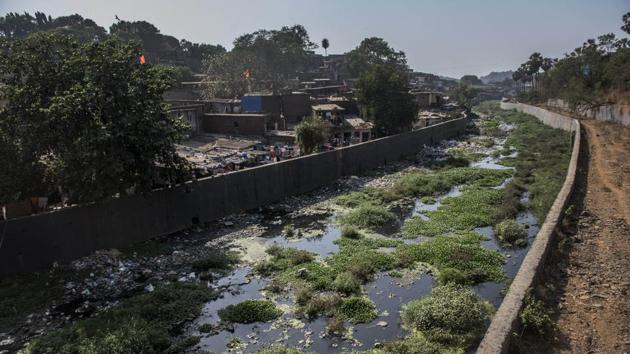Cosmetic measures will not revive Mithi river in Mumbai
Mumbai city news: ‘The river started dying in the late 1970s, when slums and industrial units came up along its banks’
The Mithi, which travels nearly 15 km along Mumbai’s suburbs before emptying into the Arabian Sea, is more of a sewage channel than a river. Until mid 1970s, it was a lively stream. Godfrey Pimenta, a lawyer from Marol, one of the old villages located on the river’s bank, remembers wading in its waters as a child. “There was clear water even in summer, though it was only a few feet deep,” says Pimenta.

The river started dying in the late 70s, when slums and industrial units came up along its banks. These areas, which were not connected to the sewage network, emptied their waste into Mithi. The river is now a septic drain.
HT had reported in May that pollution levels in the river are 13 times the safe limit, making the water unfit for aquatic life.
In 2005, after a deluge that caused the choked river to overflow, spreading death and devastation, the government formed the Mithi River Development and Protection Authority. One of the plans was to construct concrete embankments along the river. The retaining walls — not a good idea, say environmentalists — have been built only along the river’s lower reaches, along the Bandra-Kurla Complex. Little else has been done to revive the river.
Last week, the HT reported that the upper reaches of the river were chocking with hyacinth, an exotic weed. In the lower reaches, the putrefying waste was releasing biological foam. Following the press coverage, the BMC has started removing the hyacinth and foam. These steps could be merely cosmetic. Unless the sewage is diverted to effluent treatment plants, the river will remain a sewer.
Janak Daftari, an IIT Bombay alumni, water conservationist and a member of the group Jal Biradari, which had approached the National Green Tribunal (NGT) against the plans to build concrete bunds, said, “What I see along the river is psychosomatic; only if the root cause (of the pollution) is tackled, the river can be revived.” He added, “Cement has destroyed riverine diversity. The NGT has said the slopes of the river need to be restored; therein lies the problem. They (the state agencies) will say concreting the banks is the way to do it, but the best way to work nature is to let it do the work.” The second cause, said Daftari, is industrial effluents. “The domestic sewage is not the biggest problem; the toxicity of the water is because of industrial effluents. This has to be remedied at the source,” said Daftari.
For ideas to revive the Mithi, look at one of the biggest urban renewal projects — the restoration of Seoul’s Cheonggyecheon stream. The 8.4 km long river, which flows through the centre of the South Korean capital, has a history similar to the Mithi. In the decade after the Second World War, as South Korea, rebuilt itself, migrants from rural areas flooded into the city. They settled along the banks of the stream.
The waste from the homes turned the river into a sewage drain. In the late 50s, the unsightly river was covered with concrete and a road was built over it. In the seventies an elevated road was constructed over the river. In 2003, the city tore away the roadway, uncovered the river and replenished its water supply. Gardens, ponds and pedestrian bridges were built along the stream. The river is now a green ribbon that runs along some of the busiest areas in the city. The number of bird species around it has gone from 6 to 36, aquatic species from 5 to 53 and plant varieties from 62 to 308. A study said temperatures along the river are 3.3 to 5.9 degrees Celsius lower than surrounding areas and air quality is better.




